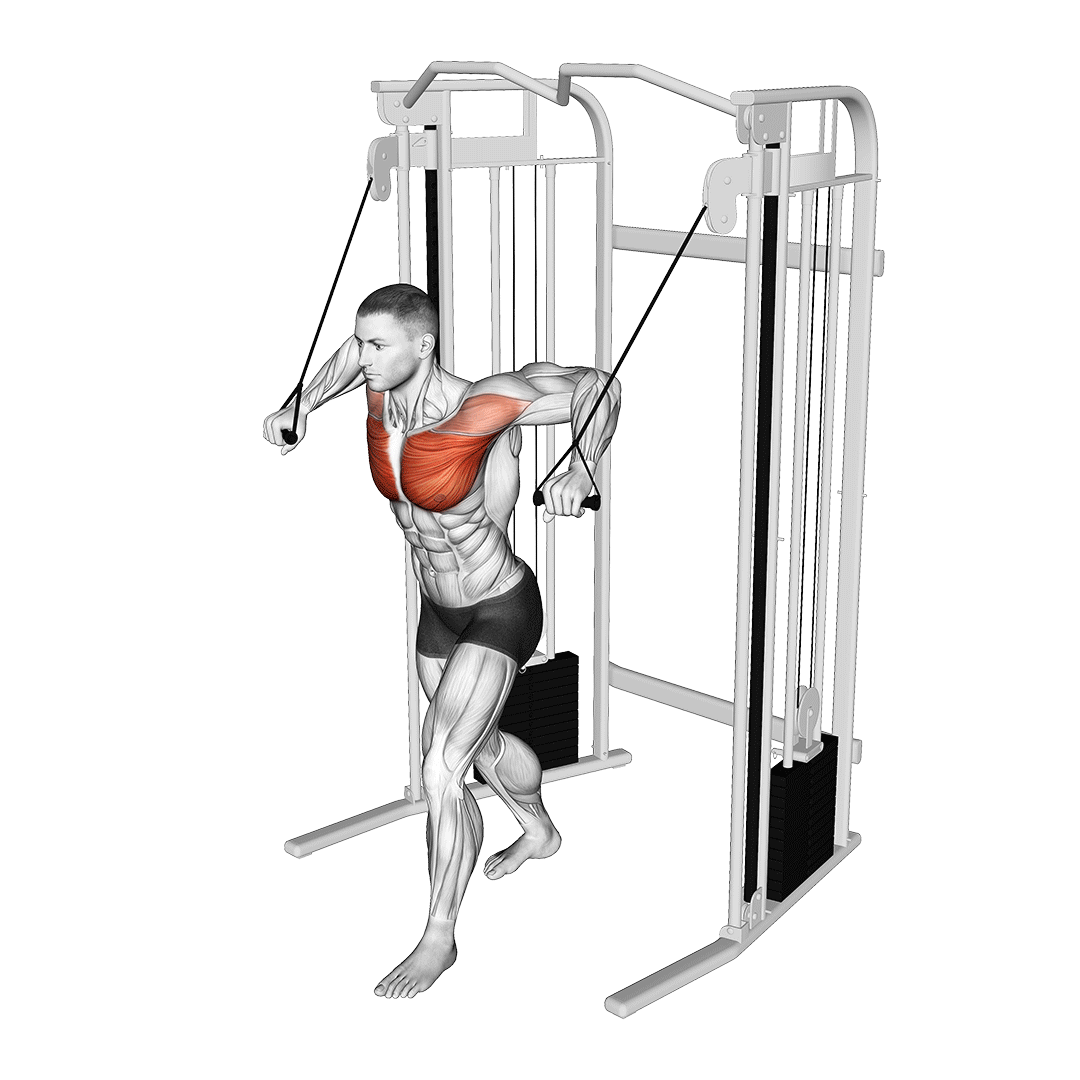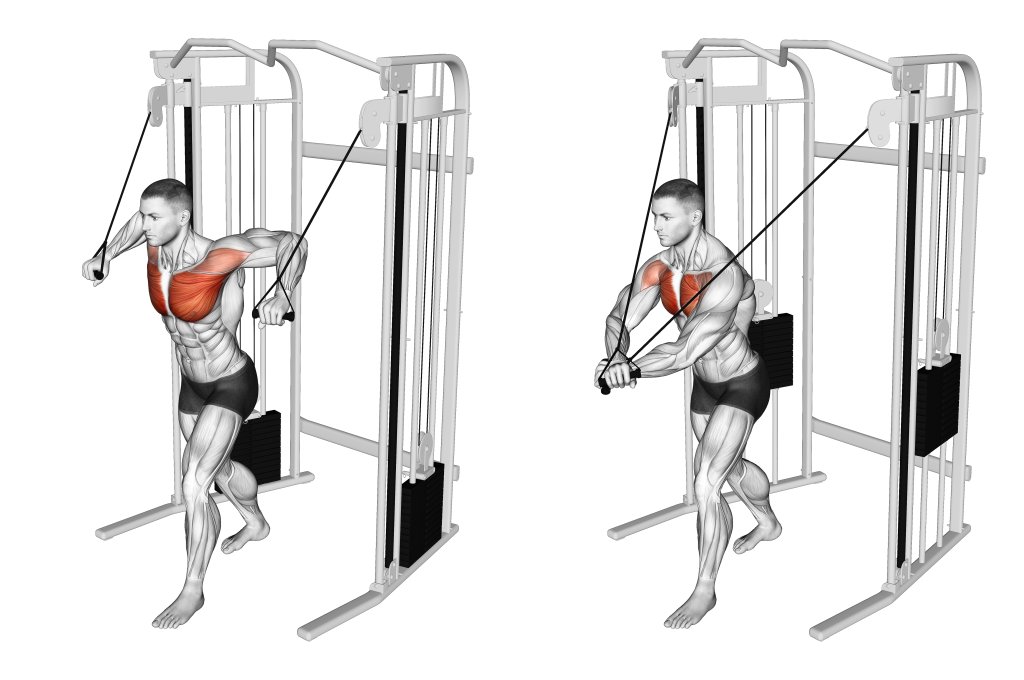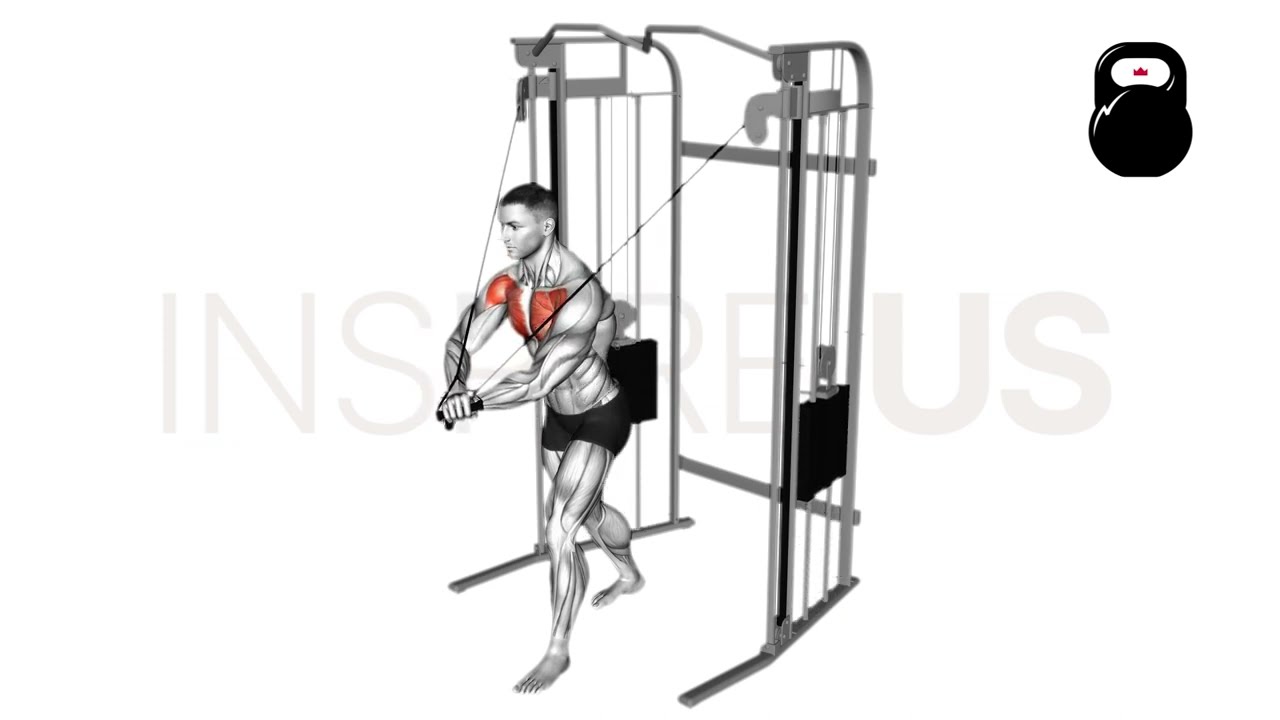Cable Crossover: Muscles Worked and More
In technical examination, the cable crossover is classified as a machine-based isolation exercise primarily involving arm adduction as its principal biomechanical action.

Cable crossovers - like other low-impact isolation exercises - serve best as an accessory movement performed for higher amounts of volume.
Performing the exercise with too much weight can directly interfere with how well the pectoral muscles are contracted, and are otherwise insufficient for overall development if used as the primary source of chest training stimulus. For the latter, try the barbell bench press, push-ups or dips.
In order to perform the exercise correctly, the lifter will require a pair of cable towers (preferably with adjustable pulleys) and a pair of single-hand attachments.
How to Do a Cable Crossover
To perform a repetition of the cable crossover, the lifter will begin by first setting the cable pulleys to a height just above shoulder-elevation, standing between the two towers and gripping a handle in each hand.
The lifter’s feet should be set in a staggered position, the arms spread out to the sides with the elbows straight but not completely locked out. The scapula should be partially retracted and depressed, core lightly braced and the entire trunk angled several degrees forwards.
If desired, lifters may maximize their range of motion by taking several steps forwards so that the pulleys are behind their body.
Now positioned correctly, the lifter proceeds by squeezing their pectoral muscles and drawing their arms towards the front of their chest - keeping them extended and straight as they do so.
As the hands come close to touching one another, the lifter squeezes their chest even further and crosses one wrist over the other.
Having completed the concentric phase of the repetition, they then allow the resistance of the cables to slowly pull their arms apart in a slow and controlled manner.
Once the arms have returned to their original position beside the torso, the repetition is considered to be complete.
Remember to switch which hand crosses over the other with each repetition.
Sets and Reps Recommendation:
Because the cable crossover is meant to be performed with only a light or moderate amount of weight, sufficient training intensity must rely on high volume and slow, controlled repetitions to properly work the chest.
2-4 sets of 8-16 repetitions should suffice for general pectoral muscle hypertrophy.
What Muscles are Worked by Cable Crossovers?
Cable crossovers are an isolation exercise, meaning that they are only meant to target a single muscle group when performed.
This muscle group is the pectoralis muscle group - of which encompasses the anterior section of the upper trunk and is principally responsible for humeral adduction and medial rotation.

The individual muscles that comprise the pectoralis muscle group are the pectoralis minor and the pectoralis major, with the latter further being divided into a clavicular (upper) and sternal (lower) head.
When performed with an angle of resistance that is horizontal to the shoulders and upper arms, both heads of the pectoralis major are worked to equal intensity.
However, greater emphasis on the upper head may be achieved by setting the pulley to a lower elevation, and greater emphasis on the lower head with a higher pulley position.
Common Cable Crossover Mistakes to Avoid
Although it is indeed true that the cable crossover is quite safe to perform, the following mistakes should be avoided for the best results out of your training.
Poor Range of Motion
As is the case with nearly all resistance exercises, failing to complete a full range of motion can lead to poor development of any muscles being targeted.
The cable crossover is no different in this regard. Each repetition must begin and end with the upper arms parallel to the sides of the torso at the least, whereas the peak of the repetition should have one wrist crossed over the other.
Hunching the Shoulders, Bending the Lower Back or Sub-Optimal Trunk Orientation
Technically three separate mistakes leading to similar issues - poor curvature of the lower back or upper trunk can lead to the spine being pulled out of a neutral position and a less advantageous position for pectoral muscle contraction.
Even in cases where neither stance error is present, the trunk itself may still be in an overly vertical orientation, leading to much the same issues. For the best results, aim for a forward incline of the trunk between 5 and 15 degrees.
To correct forward-hunching of the shoulders, the scapula must be partially retracted and depressed as the chest is puffed outwards. Likewise, to correct flexion of the lower back, the lifter should lightly brace their core and aim to bend forwards at the hips, rather than the back.
Upper Arms Above the Shoulders
In order to reduce irritation of the shoulder’s labrum and prevent impingement, the upper arms should remain angled below the shoulders.
Allowing the elbows - and subsequently the humerus - to rotate and extend while above the shoulder can greatly increase risk of injury and create a disadvantageous position for arm adduction.
For the best results, aim to keep the elbows and the upper arms beneath the horizontal parallel point created by the top of your deltoids. In most cases, this particular error is a result of the cable pulleys either being too high or not being far enough behind the trunk.
Contraction of the Biceps
It is important to remember that the cable crossover is meant to be a chest isolation exercise. Involving the elbow flexor muscles (especially the biceps) by allowing the elbows to bend can draw emphasis away from the pectorals, leading to poor development therein.
Because the biceps are primarily contracted through elbow flexion with a supinated wrist orientation, preventing their involvement in a crossover is as simple as keeping the elbows stationary throughout the set.
Minimize elbow flexion as much as possible, keeping the arms straight for the best results.
Fully Extending the Elbow
In the opposite direction to accidentally contracting the biceps, fully extending the elbows can lead to greater strain throughout the arm’s joints and a shift towards contraction of the deltoid muscles.
Much like allowing excessive elbow flexion to take place, locking out the elbows creates a less advantageous movement pattern and poorer chest muscle development.
Each repetition of the cable crossover should be performed with only a mild bend to the elbows, just short of actually locking the joint into place.
Some level of elbow extension can occur at the top of the repetition so as to maximize pectoral “squeeze”, but otherwise the elbows must be prevented from locking out.
Using a Pronated Grip/Pressing the Handles
To avoid turning the cable crossover into a cable chest press, lifters will be better served by avoiding an overhand grip - especially if they consistently find their elbows bending excessively near the start or end of the repetition.
Though the cable chest press is an entirely effective exercise in its own right, the cable crossover is meant to be a high volume pectoral isolation exercise, whereas the chest press is an entirely separate compound movement involving the triceps and anterior deltoids.
Frequently Asked Questions (FAQ)
Is Cable Crossover Upper or Lower Chest?
The cable crossover targets both sections of the chest in equal measure - provided that the angle of resistance allows for it.
The upper section of the pectoralis major may be targeted to a greater degree by setting the cable pulleys lower, whereas the lower section may be worked with the opposite adjustment.
What is the Best Position for Cable Crossovers?
Apart from targeting a specific section of the pectoralis major, the cable crossover will respond best with the trunk hinged forwards at the hips between 5-15 degrees. This will ensure minimal biceps and deltoid contraction while emphasizing the entire pectoral muscle group.
Is the Cable Crossover Good for Beginners?
Absolutely. So long as attention is paid to proper form and weight is kept to a moderate level, beginners can easily build their pec muscles with the cable crossover.
References
1. López-Vivancos, Abraham, Noelia González-Gálvez, Francisco Javier Orquín-Castrillón, Rodrigo Gomes de Souza Vale, and Pablo Jorge Marcos-Pardo. 2023. "Electromyographic Activity of the Pectoralis Major Muscle during Traditional Bench Press and Other Variants of Pectoral Exercises: A Systematic Review and Meta-Analysis" Applied Sciences 13, no. 8: 5203. https://doi.org/10.3390/app13085203
2. Jagessar, Miguel & Gray, Michael. (2009). Optimizing Development of the Pectoralis Major.
3. Schütz, Pascal, Pia Zimmer, Fabian Zeidler, Michael Plüss, Katja Oberhofer, Renate List, and Silvio Rene Lorenzetti. 2022. "Chest Exercises: Movement and Loading of Shoulder, Elbow and Wrist Joints" Sports 10, no. 2: 19. https://doi.org/10.3390/sports10020019

